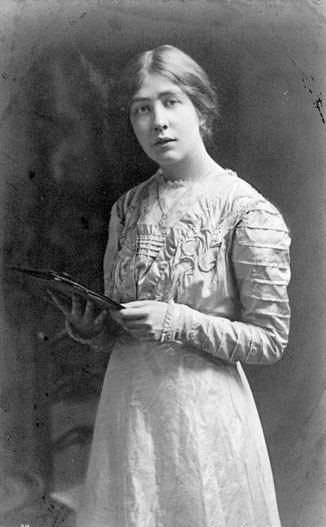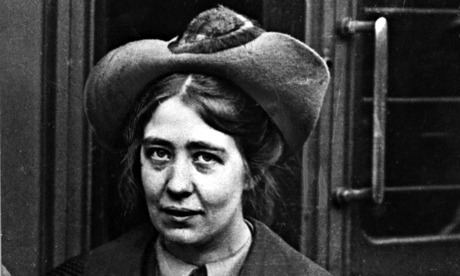Parents Emmeline Pankhurst | Name Sylvia Pankhurst Children Richard Pankhurst | |
 | ||
Full Name Estelle Sylvia Pankhurst Occupation Political activistWriterArtist Siblings Christabel Pankhurst, Adela Pankhurst Books suffragette movement, The life of Emmeline Pankhurst, Ex‑Italian Somaliland, Non‑Leninist Marxism: Writings o, Delphos: The Future of Internat Similar People | ||
Katherine connelly biographer sylvia pankhurst womens history is not jack the ripper 04 08 15
Estelle Sylvia Pankhurst (5 May 1882 – 27 September 1960) was an English campaigner for the suffragette movement in the United Kingdom. She was for a time a prominent left communist who then devoted herself to the cause of anti-fascism.
Contents
- Katherine connelly biographer sylvia pankhurst womens history is not jack the ripper 04 08 15
- Katherine connelly campaign co ordinator and author of biography of sylvia pankhurst emily wilding davison memorial campaign launch firebox 29 11 12
- Early life
- Suffragism
- First World War
- Communism
- International Auxiliary Language Movement
- Partner and son
- Supporter of Ethiopia
- Death
- Writings selection
- Secondary literature
- References

Katherine connelly campaign co ordinator and author of biography of sylvia pankhurst emily wilding davison memorial campaign launch firebox 29 11 12
Early life

Estelle Sylvia Pankhurst (she would later drop the first forename) was born in Manchester, a daughter of Dr. Richard Pankhurst and Emmeline Pankhurst, members of the Independent Labour Party and (especially Emmeline) much concerned with women's rights. She and her sisters attended the Manchester High School for Girls. Her sisters, Christabel and Adela, were also suffragists. She trained as an artist at the Manchester School of Art, and, in 1900, won a scholarship to the Royal College of Art in South Kensington. In 1907, she toured the industrial towns of the North of England and in Scotland painting working class women in their work environment.
Suffragism

In 1906, Sylvia Pankhurst started to work full-time with the Women's Social and Political Union (WSPU) with her sister and her mother. In contrast to them she retained an affiliation with the labour movement, and, unlike them, she concentrated her activity on local campaigning with the East London Federation of the WSPU, rather than leading the national organisation. Sylvia Pankhurst contributed articles to the WSPU's newspaper, Votes for Women, and, in 1911, she published a propagandist history of the WSPU's campaign, The Suffragette: The History of the Women's Militant Suffrage Movement. By 1914 Sylvia had had many disagreements with the route the WSPU was taking: while the WSPU had become independent of any political party, she wanted an explicitly socialist organisation tackling wider issues than women's suffrage, aligned with the Independent Labour Party.
She had a close personal relationship with anti-war Labour politician Keir Hardie. In 1914, she broke with the WSPU to set up the East London Federation of Suffragettes (ELFS), which over the years evolved politically and changed its name accordingly, first to Women's Suffrage Federation and then to the Workers' Socialist Federation. She founded the newspaper of the WSF, Women's Dreadnought, which subsequently became the Workers' Dreadnought. It organised against the war, and some of its members hid conscientious objectors from the police.
First World War
During the First World War, Sylvia was horrified to see her mother, Emmeline, and her sister, Christabel, become enthusiastic supporters of the war drive and campaigning in favour of military conscription. She herself was opposed to the war. Her organisation attempted to organise the defence of the interests of women in the poorer parts of London. It set up "cost-price" restaurants to feed the hungry without the taint of charity. It also established a toy factory to give work to women who had become unemployed because of the war.
She worked to defend soldiers' wives rights to decent allowances while their husbands were away, both practically by setting up legal advice centres and politically by running campaigns to oblige the government to take into account the poverty of soldiers' wives. She supported the International Women's Peace Congress, held in 1915 at The Hague. This support lost her some of her allies at home and contrasted sharply with the stance of her sister Christabel, who following the February 1917 Russian Revolution and Alexander Kerensky's rise to power, journeyed to Russia to advocate against its withdrawal from the war.
Communism
The WSF continued to move leftwards and hosted the inaugural meeting of the Communist Party. Workers' Dreadnought published Pankhurst's "A Constitution for British Soviets" at this meeting. This was an article in which she highlighted the role of Household Soviets – "In order that mothers and those who are organisers of the family life of the community may be adequately represented, and may take their due part in the management of society, a system of household Soviets shall be built up".
The CP(BSTI) was opposed to parliamentarism, in contrast to the views of the newly founded British Socialist Party which formed the Communist Party of Great Britain (CPGB) in August 1920. The CP(BSTI) soon dissolved itself into the larger, official Communist Party. This unity was short-lived and when the leadership of the CPGB proposed that Pankhurst hand over the Workers Dreadnought to the party she revolted. As a result, she was expelled from the CPGB and moved to found the short-lived Communist Workers Party. By this time, she was an adherent of left or council communism. She attended meetings of the Communist International in Russia and Amsterdam, and those of the Italian Socialist Party. She disagreed with Lenin on important points of Communist theory and strategy and was supportive of "left communists" such as Anton Pannekoek.
International Auxiliary Language Movement
Pankhurst also applied her energies to the consideration of a satisfactory International Auxiliary Language. To this end, she wrote and published a monograph on the topic in which she considers the history of the movement, historical and contemporary attempts at creating a non-national interlanguage and delves into the issues of how the ideal interlanguage should look, what conditions it should satisfy and how it should be implemented.
Partner and son
Sylvia Pankhurst objected to entering into a marriage contract and taking a husband's name. Near the end of the First World War, she began living with Italian anarchist Silvio Corio and moved to Woodford Green, where she lived for over 30 years. A blue plaque and Pankhurst Green opposite Woodford tube station commemorate her ties to the area. In 1927, at the age of 45, she gave birth to a son, Richard. As she refused to marry the child's father, her own mother, Emmeline Pankhurst, broke ties with her and did not speak to her again.
Supporter of Ethiopia
In the early 1930s, Pankhurst drifted away from communist politics, but remained involved in movements connected with anti-fascism and anti-colonialism. In 1932, she was instrumental in the establishment of the Socialist Workers' National Health Council. She responded to the Italian invasion of Ethiopia by publishing The New Times and Ethiopia News from 1936, and became a supporter of Haile Selassie. She raised funds for Ethiopia's first teaching hospital and wrote extensively on Ethiopian art and culture; her research was published as Ethiopia, a Cultural History (London: Lalibela House, 1955).
From 1936, MI5 monitored Pankhurst's correspondence. In 1940, she wrote to Viscount Swinton as the chairman of a committee investigating Fifth Columnists, sending him a list of active Fascists still at large and of anti-Fascists, who had been interned. A copy of this letter on MI5's file carries a note in Swinton's hand reading "I should think a most doubtful source of information."
After the post-war liberation of Ethiopia, she became a strong supporter of union between Ethiopia and the former Italian Somaliland, and MI5's file continued to follow her activities. In 1948, MI5 considered strategies for "muzzling the tiresome Miss Sylvia Pankhurst". Pankhurst became a friend and adviser to the Ethiopian Emperor Haile Selassie and followed a consistently anti-British stance. She moved to Addis Ababa at Haile Selassie's invitation in 1956 with her son, Richard, and founded a monthly journal, New Times and Ethiopia News, which reported on many aspects of Ethiopian life and development.
Death
She died in Addis Ababa in 1960, aged 78, and received a full state funeral at which Haile Selassie named her "an honorary Ethiopian". She is the only foreigner buried in front of Holy Trinity Cathedral in Addis Ababa, in a section reserved for patriots of the Italian war.
